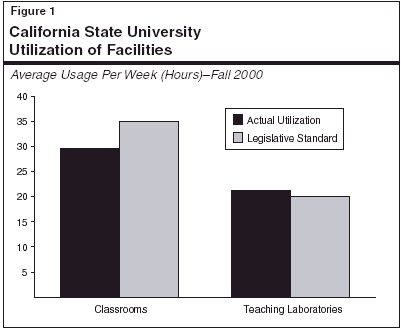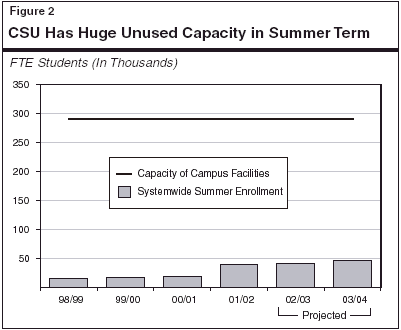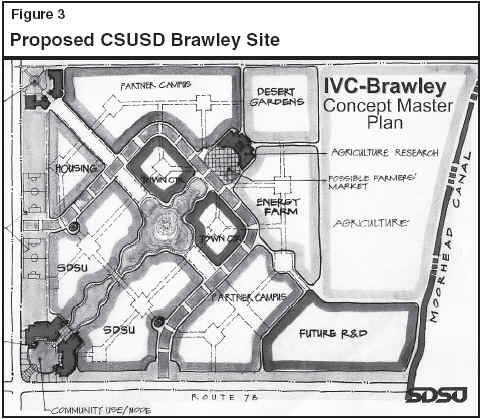Legislative Analyst's OfficeAnalysis of the 2003-04 Budget Bill |
California State University (6610)
The budget proposes $198 million from the Higher Education Capital Outlay Bond Fund of 2002 for the California State University's (CSU) capital program. Of this total $192 million is for eight major capital outlay projects and $6 million for minor projects systemwide.
We recommend the Legislature approve the CSU capital outlay budget as proposed. We have concerns, however, about CSU's capital outlay plan, as discussed below.
Utilization of Teaching Laboratories Meets Legislative Standard But Classrooms Lag
We recommend the Legislature adopt supplemental report language directing the California State University to delete projects involving construction of new classrooms from its capital outlay plan if the enrollment could be accommodated instead by utilizing existing classrooms at the legislatively approved standards.
Utilization standards approved by the Legislature call for instructional stations (such as a desk in a classroom or a workspace in a teaching laboratory) to be in use a minimum amount during the week. The standard for classrooms is 35 hours per week and for teaching laboratories is, on average, 20 hours. The Supplemental Report of the 2002 Budget Act directed CSU to report biennially on its utilization of instructional facilities. The first report was received in November 2002.
The CSU report indicates its teaching laboratory stations are in use an average of 21.2 hours per week—106 percent of the legislative standard. Classroom stations, however, are used an average of 29.6 hours per week—only 85 percent of the standard (see Figure 1, next page).

Classroom utilization ranged from a low of 24.5 hours per week at Monterey Bay to a high of 38.8 hours at San Luis Obispo. Teaching laboratory utilization ranged from 12.9 hours per week at Dominguez Hills to 26.6 hours at Bakersfield.
Because efficient utilization of facilities is important to reducing the need to construct new instructional buildings, we recommend the Legislature adopt supplemental report language directing CSU to delete classroom projects from its capital outlay plan if the enrollment could be accommodated instead using existing classrooms at the legislatively approved standards.
Capital Outlay Program Does Not Fully Reflect Year-Round Operation
We recommend the Legislature direct California State University to delete from its capital outlay plan projects involving new instructional space that is justified solely on the basis of enrollment growth until it is utilizing existing instructional space during the summer at about the same level as in other terms.
Full Summer Enrollment Could Accommodate Thousands of Additional Students. The 23 CSU general campuses have enough facilities to physically accommodate about 295,000 full-time equivalent (FTE) students at a time. The university does operate its campuses during summer term, but nowhere near its full capacity. As Figure 2 shows, projected summer enrollment in the budget year will be about one-sixth of physical capacity.

CSU Plans Only Slight Growth in Summer Enrollment—and $1 Billion for New Instructional Facilities. The university's capital outlay plan is based on the assumption it will deliver instruction to 50,000 FTE in the 2003-04 summer term, increasing to 58,000 by 2009-10. As Figure 2 indicates, this still leaves an enormous amount of unused capacity during the summer term. At the same time, however, the university's capital outlay program proposes to spend over $1 billion of state funds in the next five years to construct new instructional facilities. The increase in space would be equal to the instructional capacity of the Dominguez Hills, San Marcos, and Sonoma campuses combined.
The Legislature has previously expressed its intent that CSU operate its facilities year-round. Although the university has made progress in implementing year-round operation, it continues to plan construction of instructional facilities in the next five years that will cost the state about $1 billion—even though much, if not all, of this space would not be necessary if campuses fully utilized their facilities in the summer. Eliminating unnecessary construction would free up hundreds of millions of dollars of scarce state resources for other high priority projects in higher education or other areas of the budget. Therefore, we recommend the Legislature direct CSU to delete from its capital outlay plans construction of new instructional space that is justified solely on the basis of enrollment growth.
CSU Plans at Brawley Are Unclear
We recommend the Legislature direct California State University to report on its intentions for an off-campus center or campus at Brawley, the potential state capital outlay costs, and the nature of the commitments it has made.
The CSU San Diego campus plans to accept a gift of 200 acres of land outside Brawley (Imperial County) from a real estate developer as a site for a future off-campus center. The CSU indicates that a developer will construct a building that will be leased to CSU for the San Diego campus to offer courses and degree programs. When the enrollment reaches about 500 FTE students, CSU plans to submit a needs assessment to the California Postsecondary Education Commission in order to establish the facility as an off-campus center of the San Diego campus.
We are concerned with aspects of this plan because they may set CSU on a course that could result in significant capital outlay costs for the state—without the Legislature having had an opportunity to consider the need for the project. Points about which we are concerned are:
- The amount of land CSU is planning to accept is far more than an off-campus center can reasonably be expected to utilize. The San Diego campus, with an enrollment of about 25,000 FTE students, is comprised of 283 acres. It is unclear why CSU would accept a gift of 200 acres if only an off-campus center were planned.
- A concept master plan the San Diego campus has prepared shows two large parts of the site to be occupied by "partner campuses" (see Figure 3, next page). It is not clear who these partners are and what commitments they have made to the project. If the partners are a community college district or the University of California, the Legislature should know if their plans would entail state funding.

- The concept master plan indicates major CSU construction at the site. It includes a library, computer building, energy museum, student center, administration building, several classroom buildings, and a solar-powered clock tower (see Figure 4, next page). This appears to be much more than would be appropriate at an off-campus center.
- San Diego State has an existing off-campus center at Calexico (also in Imperial County), 26 miles from Brawley, with a physical capacity of 775 FTE students and a year-round instructional capacity of about 1,100 FTE. Enrollment is about 500 FTE students at the Calexico center. It is not clear that there is a need for two off-campus centers in this area.
We believe the Legislature needs better information about this project and its potential state funding impact. The amount of land being acquired and the concept plans CSU has prepared are suggestive of something more than an off-campus center—such as an entire new campus at sometime in the future. We believe the Legislature should have complete information about CSU's plans and intentions before commitments are made that could require major funding by the state. Accordingly, we recommend that CSU report at hearings on its intentions for an off-campus center or campus at Brawley, its potential state costs, and the nature of the commitments it has made.
